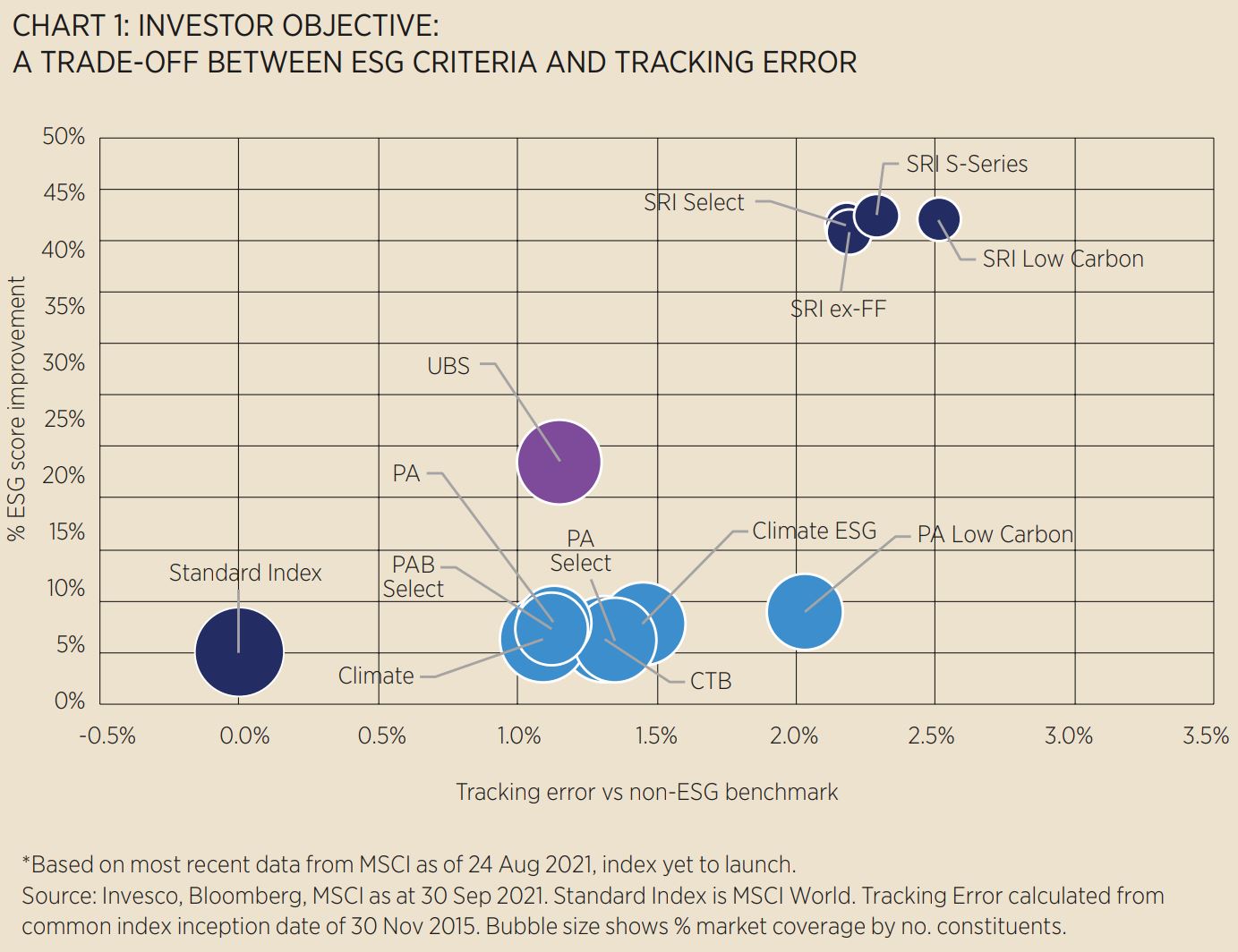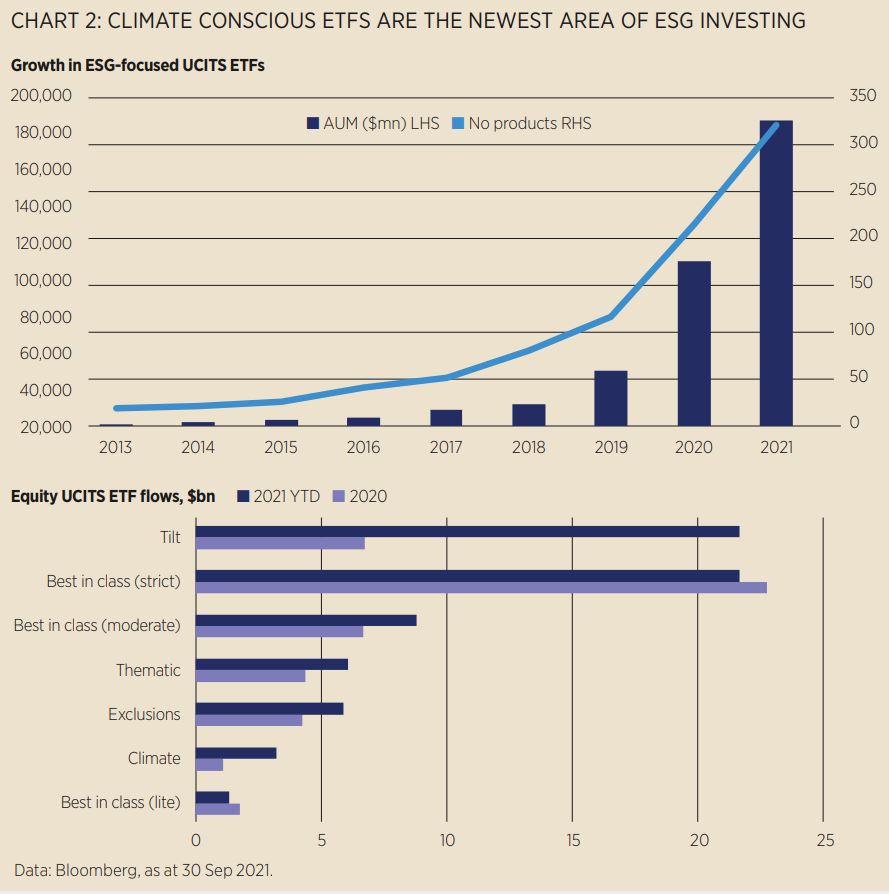Dr. Christopher Mellor, head of EMEA ETF equity and commodity product management at Invesco, has said an area of the market that is currently underserved by ETF issuers is combining ESG metrics with the European Union’s Paris Aligned (PAB) and Climate Transition Benchmarks (CTB).
Speaking to ETF Stream, Mellor said indices tracking the two climate benchmarks introduced by the EU in 2019 typically do not offer investors an improvement in ESG scores versus their respective parent indices (see Chart 1).

The climate ETF space has been one of the most competitive areas of the market in recent years following the launch of the first product linked to the PAB or CTB in March 2020. According to data from MSCI, there are currently 38 climate ETFs listed in Europe with around $10bn assets under management (AUM). By tracking the PAB and CTB, climate ETFs meet specific rules set out by the European Commission that align with carbon emission reductions while also encouraging companies to meet the 1.5°C targets of the Paris Agreement.
However, Invesco’s Mellor sees a significant opportunity in adding an extra dimension to the space by launching climate ETFs that incorporate ESG criteria. As a result, the US giant is looking to launch an ETF in the near future that achieves just this.
“ETFs linked to the PAB and CTB do not currently lead to a meaningful improvement in ESG score and do not have many significant business exclusions,” he said. “This is one aspect that is currently being underserved. It is a difficult trade-off to achieve but it is something we are seeing big demand for at the moment.”
Overall, Mellor stressed there has been a significant “step change” in investor behaviour from an ESG perspective as the space becomes more mainstream. In particular, he said there has been an increase in demand for more benchmark aware-type ESG ETFs that want more of a light-touch approach.
While around 50% of flows into ETFs listed in Europe in 2021 have been into ESG strategies, according to Invesco, the type of strategy which has seen significant demand has shifted. There has been a huge increase in tilted ESG ETFs this year (see Chart 2) while the share of inflows into a strict best-in-class approach has dropped slightly from 2020.

“ESG investing has become mainstream,” Mellor continued. “In the early stages of ESG ETFs, investors wanted a deep green – or SRI – approach.
As views become more nuanced, what we see now is a broader array of options investors are selecting. For Invesco, it is important to offer investors options that meet their own requirements.”
Lessons from COP26
All eyes were on the COP26 summit in Glasgow in November as global leaders rushed to agree a deal that will enable the world to hit the targets of the Paris Agreement set six years ago. Mellor said there were definitely some positives from the summit but also some negatives and made reference to scientist estimates that even if all the pledges committed to are met then the world will be short of the 1.5°C target.
Despite this however, he stressed there were a number of important agreements including the reference to coal as part of the final summit pact – even though the wording was toned down – and successful wins around methane reduction and deforestation.
“I am naturally an optimist but it certainly was not a full victory,” he warned. “From an investor perspective, governments cannot be relied on to deliver all we need to combat climate change and meet global warming goals. Investors and companies need to step up and respond to carbon reduction needs.”
In particular, the big winners from COP26, Mellor predicted, will be clean energy and solar which are both essential in the transition to a low carbon economy. Highlighting this, solar usage is expected to increase from 11% in 2019 to 38% in 2050 as part of the global installed electricity capacity mix while wind is set to jump to 20%, up from 8%.
In August, Invesco launched Europe’s second solar ETF, the Invesco Solar Energy UCITS ETF (ISUN), ETF Stream revealed. ISUN tracks the MAC Global Solar Energy index which currently offers exposure to 46 companies involved in the transition to solar energy.
Engagement
Another area of increasing focus for investors is around ETF issuer engagement. One criticism typically thrown at passive strategies is because they are passive, they do not engage with underlying companies and therefore, do not hold management to account. Mellor stressed this is a “lazy” conclusion to reach as many passive managers are the world’s largest asset managers which also run active houses.
In Invesco’s case, the engagement approach from an ETF perspective is combined with the wider firm meaning there is consistent proxy voting and dialogue with the underlying companies they own.
On the question of divestment, Mellor stressed the importance of retaining power in the conversation. “If you divest from the more carbon-intensive areas, there will still be another investor owning those stocks as every time you sell on the secondary market, someone else is buying. If that buyer is less engaged on climate, then pressure is off for management. Engagement is a better option than divestment as ultimately you keep your voice.”
Industry Interviews is a series where ETF Stream and its partners analyse some of the key trends from across the European ETF market
This article first appeared in ETF Insider, ETF Stream's new monthly ETF magazine for professional investors in Europe. To access the full issue, click here.


